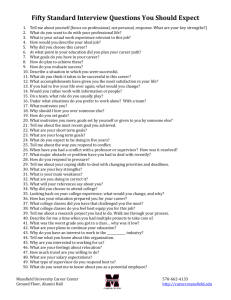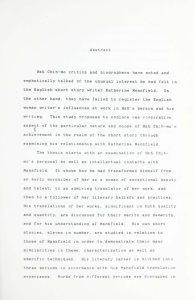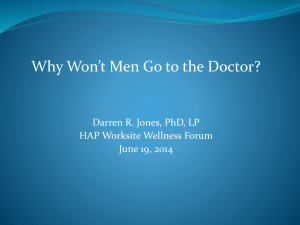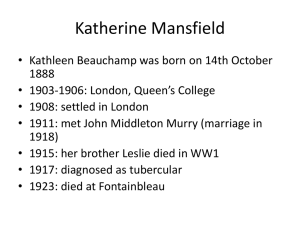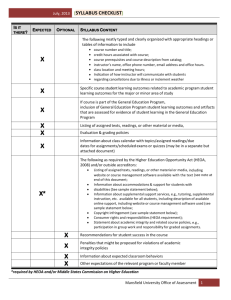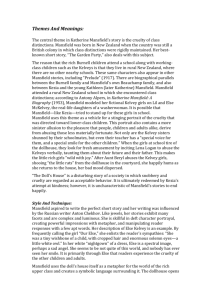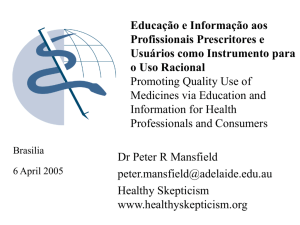Pharmaceutical promotion
advertisement
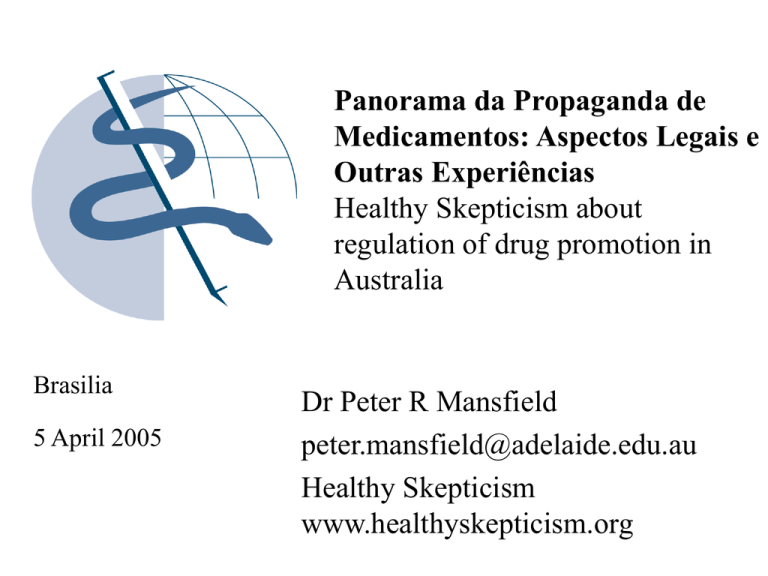
Panorama da Propaganda de Medicamentos: Aspectos Legais e Outras Experiências Healthy Skepticism about regulation of drug promotion in Australia Brasilia 5 April 2005 Dr Peter R Mansfield peter.mansfield@adelaide.edu.au Healthy Skepticism www.healthyskepticism.org Topics 1. 2. 3. 4. 5. Thank you Introduction to Healthy Skepticism The problem Current regulation in Australia Ideas for better regulation 2 1. Thank you • Traditional owners • ANVISA and PAHO • My family, employer and Healthy Skepticism especially A/Prof Chris Doecke • Brazilian Embassy in Canberra • Translators • Audience • Brazilian Citizens 3 2. Introduction to Healthy Skepticism Countering misleading drug promotion www.healthyskepticism.org 4 History • 1981-82 Bangladesh • MaLAM (Medical Lobby for Appropriate Marketing) • Letters to drug companies based on Amnesty International • Effective in the 1980s, less so in the 1990s • Now exploring many strategies 5 “The best defense doctors can muster against this kind of advertising is a healthy skepticism and a willingness, not always apparent in the past, to do homework. Doctors must cultivate a flair for spotting the logical loophole, the invalid clinical trial, the unreliable or meaningless testimonial, the unneeded improvement and the unlikely claim. Above all, doctors must develop greater resistance to the lure of the fashionable and the new.” Garai PR. Advertising and Promotion of Drugs. in: Talalay P. Editor. Drugs in Our Society. Baltimore: 6 John Hopkins Press; 1964. Healthy Skepticism • Philosophy: Accepting claims that are justified, rejecting those that are not, regardless of comfort. • Aim: Improving health by reducing harm from misleading drug promotion. • Methods: Research, education and advocacy. 7 Recent major publications 1 Mansfield PR, Vitry AI, Wright JM. [letter] Withdraw all COX-2selective drugs. MJA 2005; 182 (4):197. Mansfield PR, Mintzes B, Richards D, Toop L. [editorial] Direct to consumer advertising. BMJ. 2005 Jan 1;330(7481):5-6. Mansfield P. Accepting what we can learn from advertising's mirror of desire. [commentary] BMJ. 2004 Dec 18;329(7480):1487-8. Jureidini J, Tonkin A, Mansfield PR. [letter] TADS study raises concerns. BMJ. 2004 Dec 4;329:1343-4. Allen K, Mansfield P. Changing attitudes to 'the change'. Aust Fam Physician. 2004 Nov;33(11):939-40. Mansfield PR, Henry D. Misleading drug promotion-no sign of improvements. [editorial] Pharmacoepidemiol Drug Saf 2004;13(11):797-9. Rogers WA, Mansfield PR, Braunack-Mayer AJ, Jureidini JN. The ethics of pharmaceutical industry relationships with medical students. MJA 2004 Apr 19;180(8):411-4. 8 Recent major publications 2 Mansfield P, Henry D, Tonkin A. Single-enantiomer drugs: elegant science, disappointing effects. [editorial] Clin Pharmacokinet 2004;43(5):287-90. Jureidini JN, Doecke CJ, Mansfield PR, Haby MM, Menkes DB, Tonkin AL. Efficacy and safety of antidepressants for children and adolescents. BMJ 2004;328:879-83 Svensson S, Mansfield PR. Escitalopram: superior to citalopram or a chiral chimera? Psychother Psychosom 2004 Jan-Feb;73(1):106. Mansfield PR. Healthy Skepticism’s new AdWatch: understanding drug promotion. MJA 2003; 179 (11/12): 644-645 Jureidini J, Mansfield P, Menkes D The statin wars. [letter] Lancet 2003 Nov 29; 362(9395)1854 Katz D, Mansfield P, Goodman R, Tiefer L, Merz J. Psychological aspects of gifts from drug companies. [letter] JAMA 2003 Nov 12;290(18):2404-5 9 Harry Potter 3: Professor Lupin • Poor but honest • Defense against the dark arts teacher 10 The Matrix 1: Morpheus’ choice for Neo Believe what suits you or face the evidence 11 Bad news 1. 2. 3. 4. 5. 6. Doctors are human Drug companies are companies We have a system problem People are being harmed No proven solutions No one solution will be enough alone 12 Good news • There are ideas for solutions supported by evidence from other fields • Some solutions may be sufficient alone but still necessary thus worthwhile • The zeitgeist is changing • Perhaps we are near a tipping point 13 Beware attribution errors • Not very useful to blame individuals or companies. • The main determinate of behavior is the situation. • If we improve the information and incentives that the actors receive then their behavior may improve. 14 Treat the cause (main causes) • Drug companies are rewarded for increasing sales regardless of impact on health. • Doctors are human decision makers who are vulnerable to being misled. • Drug companies are rewarded if they mislead. • They can feel better if they believe their own propaganda via groupthink. 15 Adelaide 16 17 Visitors to www.healthyskepticism.org 51% Non-Profit Organisation 17.6% US Commercial 9.6% Network 7.8% Unknown 4.8% Australia 2.5% Brazil 1. 7% Canada 1% US Educational 0.6% United Kingdom 0.3% Netherlands 18 3. The problem Promotion is a tool for good or ill. Good to focus on promotion that may increase inappropriate prescribing and thus do harm. Direct harm Opportunity costs 19 Misleading promotion: main types • False information - Who knows the truth? • Ambiguous information – Who says what it means? • Omission of information – How do you detect it? • Irrelevant information – How do you prove it is harmful? • Triggering short cuts (eg newer if better) - How do you prove it? 20 Vioxx being able to once again take a grandchild for a walk is a major victory. 21 Estimated toll from Vioxx “…the increased risk of 16 events per 1000 patients treated for up to 3 years… …a potential excess of several thousand cardiovascular events caused by rofecoxib. This may represent an underestimate of the number of events caused by rofecoxib, because patients with inflammatory arthritis are likely to be at higher baseline risk of cardiovascular events than the “low risk” population included in APPROVe.” Langton PE, Hankey GJ, Eikelboom JW. Cardiovascular safety of rofecoxib (Vioxx): lessons learned and unanswered questions. Med J Aust 2004; 181 (10): 524-525. 22 When you are misled you don’t know it • • • • • Difficult to detect. Difficult to prove. Denial by companies and their staff. Denial by health professionals. Patients don’t know they have been harmed. 23 Promotion does more harm than good: Observational studies Becker MH, Stolley PD, Lasagna L, McEvilla JD, Sloane LM. Differential education concerning therapeutics and resultant physician prescribing patterns. J Med Educ 1972;47:118-27. Linn LS, Davis MS. Physicians’ orientation toward the legitimacy of drug use and their preferred source of new drug information. Soc Sci Med 1972;6:199-203. Mapes R. Aspects of British general practitioners’ prescribing. Med Care 1977;15:371-81 Haayer F. Rational prescribing and sources of information. Soc Sci Med 1982;16:2017-23. Ferry ME, Lamy PP, Becker LA. Physicians’ knowledge of prescribing for the elderly: a study of primary care physicians in Pennsylvania. J Am Geriatr Soc 1985; 33:616-21. Blondeel L, Cannoodt L, DeMeyeere M, Proesmans H. Prescription behaviour of 358 Flemish general practitioners. Paper presented at the International Society of General Medicine meeting, Prague, Spring 1987. Bower AD, Burkett GL. Family physicians and generic drugs: a study of recognition, information sources, prescribing attitudes, and practices. J Fam Pract 1987;24:612-6. Cormack MA, Howells E. Factors linked to the prescribing of benzodiazepines by general practice principals and trainees. Family Practice 1992;9:466-71. Berings D, Blondeel L, Habraken H. The effect of industry-independent drug information on the prescribing of benzodiazepines in general practice. Eur J Clin Pharmacol 1994;46:501-505. Caudill TS, Johnson MS, Rich EC, McKinney WP. Physicians, pharmaceutical sales representatives, and the cost of prescribing. Arch Fam Med 1996;5:201-6. Powers R. Time with drug reps affects prescribing. Paper presented at the Society of General Internal Medicine meeting, 1998 24 Wazana A. Physicians and the pharmaceutical industry: is a gift ever just a gift? JAMA. 2000 Jan 19;283(3):373-80 Possible causes • • • • • Profit seeking Groupthink Experts Inertia Inability 25 Groupthink 26 Profit seeking: evolutionary pressures • Companies have little choice but to maximise profits or be taken over by more aggressive competitors • Companies are paid more for increasing sales of more expensive drugs regardless of the impact on health • Companies use the methods that are most effective • If the magnitude and probability of profits exceeds the magnitude and probability of penalties then misleading promotion can be expected. 27 “As an advertising man, I can assure you that advertising which does not work does not continue to run. If experience did not show beyond doubt that the great majority of doctors are splendidly responsive to current [prescription drug] advertising, new techniques would be devised in short order.” Garai PR. Advertising and Promotion of Drugs. in: Talalay P. Editor. Drugs in Our Society. Baltimore: John Hopkins Press; 1964. 28 “And if, indeed, candor, accuracy, scientific completeness, and a permanent ban on cartoons came to be essential for the successful promotion of [prescription] drugs, advertising would have no choice but to comply.” Garai PR. Advertising and Promotion of Drugs. in: Talalay P. Editor. Drugs in Our Society. Baltimore: John Hopkins Press; 1964. 29 The golden handcuffs 30 We have a system problem • Doctors and drug companies encourage each other to do the wrong thing in a vicious cycle. • If companies over-promote their drugs effectively, doctors reward them via higher drug sales. • If doctors over-prescribe drugs, companies have more money for gifts and for promotion reinforcing doctors’ beliefs that they are doing the right thing. Sweet M. Doctors and drug companies are locked in "vicious circle“ BMJ, Oct 2004; 329: 998. 31 We need to change the system a. Increase regulation of drug promotion b. Improve health care decision making c. Redesign the incentives for health professionals d. Redesign the incentives for drug companies 32 Redesign the incentives for companies • Pay separately by open competitive tender for separate functions: – – – – – Manufacturing Research Education Promotion Advocacy • New Zealand capped annual contracts 33 Redesign the incentives for health professionals • Stop the gifts • Make the connection between more cake for drug companies and less cake for everyone else 34 4. Current regulation in Australia 35 Australian Trade Practices Act Section 52 A corporation shall not, in trade or commerce, engage in conduct that is misleading or deceptive or is likely to mislead or deceive. 36 Misleading • Ads: perhaps 100% are misleading. • Reps: At least one “inaccuracy” in 13 of 16 (81%) of visits to Aust GPs Roughead EE, Gilbert AL, Harvey KJ. Self-regulatory codes of conduct: are they effective in controlling pharmaceutical representatives' presentations to general medical practitioners? Int J Health Serv 1998;28(2):269-79. 37 Implementation • Australian Competition and Consumer Corporation • Therapeutic Goods Administration • Medicines Australia self regulatory Code or Conduct 38 Regulatory capture 39 Case study - Celebrex • Dear Dr letter just after the Vioxx withdrawal. • “The cardiovascular safety profile of Celebrex has been extensively studied. • The data do not indicate significant cardiovascular safety concerns with Celebrex.” 40 Timeline • • • • Dear Dr letter – 8 Oct 2004 My complaint – 4 Nov 2004 Finding delivered – 28 Jan 2005 “this information is confidential until notification from Pfizer of any appeal.” • Appeal – “Possible dates are 21 or 22 April.” 41 Code of Conduct Committee finding • “Some members considered that it was misleading to claim that the cardiovascular safety profile of Celebrex had been ‘extensively studied’, which implied cardiovascular safety was a primary endpoint in the studies that had been conducted. Members concluded that the statement “extensively studied” was somewhat ambiguous in its meaning,” but “the letter to doctors should not be found in breach on the basis of the use of these words.” 42 E. Ideas for better regulation Overcome regulatory swamping • Choose a high priority area (or a few) • Focus on regulating that area properly. • When that area is under control then move on to the next priority. 43 Regulatory pyramid Incapacitation Heavy sanctions Light sanctions Notification Modified from Ayers I. and Braithwaite J. Responsive regulation: Transcending the Deregulation Debate. Oxford: Oxford University Press 1994 44 Match the response to the cause Cause of non-compliance Unable Regulatory response Remove Profit seeking Costs Lacks understanding Lacks knowledge but virtuous Education / Restorative justice Notification / Education Modified from Braithwaite J. Restorative Justice and Responsive regulation. Oxford: Oxford University Press 2002 45 Restorative justice • “a process whereby all parties with a stake in a particular offense come together to resolve collectively how to deal with the aftermath of the offense and its implications for the future.” • Reintegrative shaming - confrontation then joint problem solving rather than punishment. • Evidence from other fields - more effective than courts for reducing repeat crime despite lower punishments. 46 Crime prevention • Crime prevention more likely when offenders : – perceive sanctions as legitimate – accept their shame – bonds with the community strengthened. • Focus resources not on those who gain most from crime but on those who gain little but have the power to stop it. • They may be motivated to avoid shame even when not criminally responsible. 47 Education • Update seminars (preemptive) – no accusations • Restorative justice conferences (drug co staff, victims, advocates) • Support allies – NGOs, Universities and Regulatory affairs /research /information staff, Help them meet. 48 Costs • • • • • Adverse publicity Time consuming questions Inspection fees Small Fines Large Fines – magnitude and probability > profits – avoid the deterrence trap by increasing the probability so you can reduce the magnitude 49 Incapacitation • • • • • • • Cease the one advertisement Cease promotion of that product for a time Cease all promotion for a time Cease promotion permanently Appoint an internal quality inspector Suspend or revoke individuals licenses or jail Removal of the company from the market 50 Self regulation Company self regulation essential. Industry self regulation may contribute IF the main system is working well. 51 Thank you ANVISA and PAHO • International leadership – largest meeting on drug promotion ever. • “…the possible establishment of partnerships related to drug promotion” • “We are now ready, willing, and able to collaborate with any governments, companies, universities, or organisations for health professionals or consumers who are interested in improving health while saving money.” Mansfield PR, Lexchin J, Vitry A, Doecke CJ, Svensson S. Drug advertising in medical journals. Lancet. 2003 Mar 8;361(9360):879. 52 Healthy Skepticism Countering misleading drug promotion www.healthyskepticism.org 53
